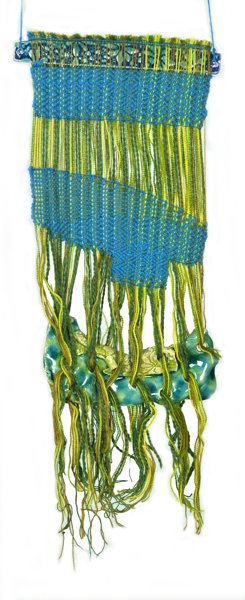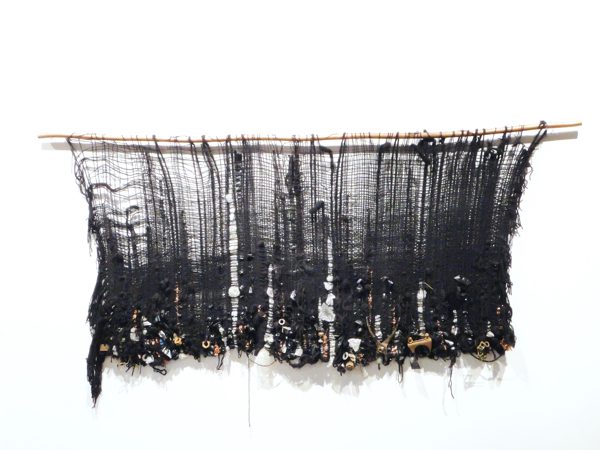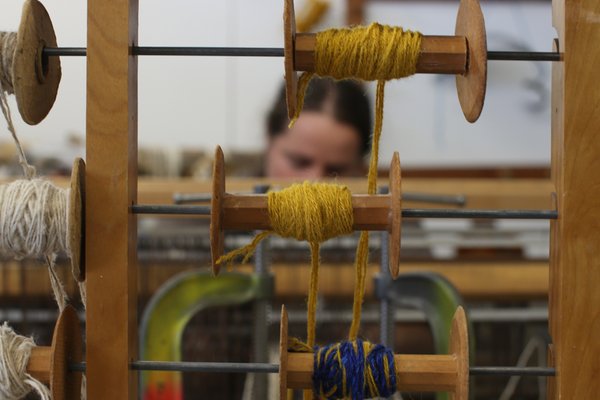“The framing of textiles as fine art
was really important to me.”
Interview by Jennifer Nelson, WTP Feature Writer

Britta Fluevog is a third-generation artist, whose grandmother was a printmaker; mother an art therapist/ mixed media artist; and father a designer. She received a Bachelor’s degree in Interdisciplinary Fine Art from NSCAD (Nova Scotia College of Art and Design) in Halifax, Canada. After graduation, she established a small ceramic co-op in Ghana, West Africa. She received a Master’s degree in applied art from Emily Carr University of Art & Design in Vancouver, Canada.
Her work explores social justice as she broaches the themes of refugees, borders, globalism, and colonization. Her mediums include weaving, sculpture, ceramics, installations, and performance. She uses local, industrial, and indigenous materials in her work as she considers their places of origin and the connotations they carry. She views the act of making art as a powerful statement that has the ability to reframe the way we engage with and view our world. Through connection to materials and ancient practices, she aims to challenge global hegemonic capitalism, championing the value of makers.
Nelson: How did your upbringing in a family of artists influence your decision to become an artist? Please also comment on where you grew up, and how place informs your artwork.
Fluevog: My grandmother put on great airs of being an artist. Of course, they were all semi-jesting. As a female, mostly in her eighties at this point, who started making art in her fifties with no gallery representation, she is not much of an artist in the world’s eyes. I do think art was really important to her identity; she was a refugee from Estonia who always felt displaced from the life/class that she was used to.
My mother brought me to art galleries in major cities like Chicago, New York, and London. Art was an interest we shared.
When I was a kid, my dad, designer John Fluevog, would sit and draw shoes at night. I would come and sit by him and design shoes as well.
Nelson: How did you come to weaving as a fine art form?

Fluevog: Weaving was always a fine art form for me. I came to weaving from ceramics—where the discourse of craft or fine art was strong. This was during my bachelor’s at NSCAD, where the ceramics department was half craft, half fine art without there being discord. In the weaving studio, almost everyone was on the craft side of the equation, but I only ever took one introduction-to-weaving course. I did, however, do some weaving in subsequent sculpture classes.
The framing of textiles as fine art was really important to me initially (subsequently, the place of textiles in the art world has changed as well as my own comfort in the medium). I avoided being termed a crafts person by not making anything that could be confused with craft. My weaving with added ceramic elements like in “Curving—Kilter Warp” is not something I would have created when I first started weaving, as it borders on simply being decorative (in a craft material) and therefore dismissed as not fine art.
Nelson: You call yourself a “radical weaver” and weaving an act of resistance. This can be seen in such works as “Crossings—Transcending the Border” and “A Struggle to Get Out—Tube Warp.” What are the advantages of this traditionally fiber craft in getting your message across?
Fluevog: There are two main reasons why fiber is a political material for me. Firstly, everyone has associations of warmth and comfort with textiles, perhaps not on a conscience level, but everyone wears and uses textiles and receives some level of comfort from them.
Secondly, fiber is inherently a political medium in our society. In our societies, historical textiles helped fuel the industrial revolution, early consumerism, and colonization. The first machine was the spinning Jenny for making thread; cloth remains a huge industry in which everyday people now have wardrobes full of clothing; cotton and dye materials such as indigo were huge imports from colonies. Textiles today are still extremely political, both ecologically and socially.
Nelson: In your woven works, you often blend non-traditional materials, such as metal, plastic, wood, and stoneware, with traditional yarns and wools. This can be seen in your Black Wool, Rusty Metal series in which you use tinfoil, bubble wrap, and scrub pads. Why is it important for you to blend materials? How does this blending enhance the message you hope to convey?

Fluevog: Juxtaposition is something I play with all of the time. It is interesting and exciting to find unusual materials; it adds texture and color; and conveys different meanings depending on the material. Weaving is an interesting way to combine items because the items create a whole and remain separate creating “marriage.”
Nelson: You’re not only a weaver, but also an artist of ceramics, sculptures, performance, and installations. Why is it important for you to use different mediums for different projects, and how do you decide which medium to use for which project?
Fluevog: Picking materials is somewhat pragmatic: there are certain things I can do in weaving, there are certain things I can do in clay; there are places/times/spaces for installation or performances. After pragmatic considerations, theme will drive the outcome unless I just want to play with a medium. Recently, I have been playing with the idea of makers, particularly the political textile makers. Clearly yarns and weaving speak to this best, but I have created quilted-like textile hands that also work in this theme; I have done performance weaving that also highlights making; and I have made a black wooden plinth alluding to the art world’s lack of status for average makers—all of these different materials to address a medium-specific idea. Multiple ways of saying the same or similar things is something I do often.

Nelson: This winter, you offered your first weaving workshop in Braunschweig, Germany, which is home to Germany’s largest art school. You also have opened your home to artist residencies. Why is this important for you to do?
Fluevog: Community is really important. Art openings are not the place to have an hour conversation about the meaning of art or sadly even an hour conversation about the art being seen. Residencies provide artists dedicated art space and time, without distractions. They tend to lack competition (usually the people there are not vying for the same galleries or grants) and don’t have the power structures that schools have. While at a residency in Banff, I cooked turkeys in the kiln for American Thanksgiving (a trick I learned from a professor, Walter Ostrom). For me, this aspect of kinship and community is vital, and in this way I can create it both for others and myself. I also love knowledge. I love to learn, to teach to share.
Nelson: Can you explain how you came to establish a small ceramic co-op in Ghana, West Africa, after graduation?
Fluevog: I planned to go to Ghana with a charity. This Christian organization saw me dancing, thought it was trance-like and didn’t want me (good riddance!!!!). So I decided to go and just travel. While I was there, I got to a village near a national park with elephants. They were really excited to hear I was an artist since they wanted some way of attracting tourists that went through their village. I also got two weaving lessons in Peru by just going there. Flying by the seat of my pants is more my style than planning.
Nelson: How do you see your artwork evolving in the future?
Fluevog: I recently did a project at the Technical University of Braunschweig, where with the help of students, I decorated the façade of a building. I also did a nude photo shoot of me pregnant working at a cement factory. These projects lead me to believe that I will be able to grow and change what I think about myself as an artist.
You can see Fluevog’s work in this month’s WTP Vol. VI #1 and on her site at http://brittafluevog.blogspot.com/
Copyright 2018 Woven Tale Press LLC. All Rights Reserved.

